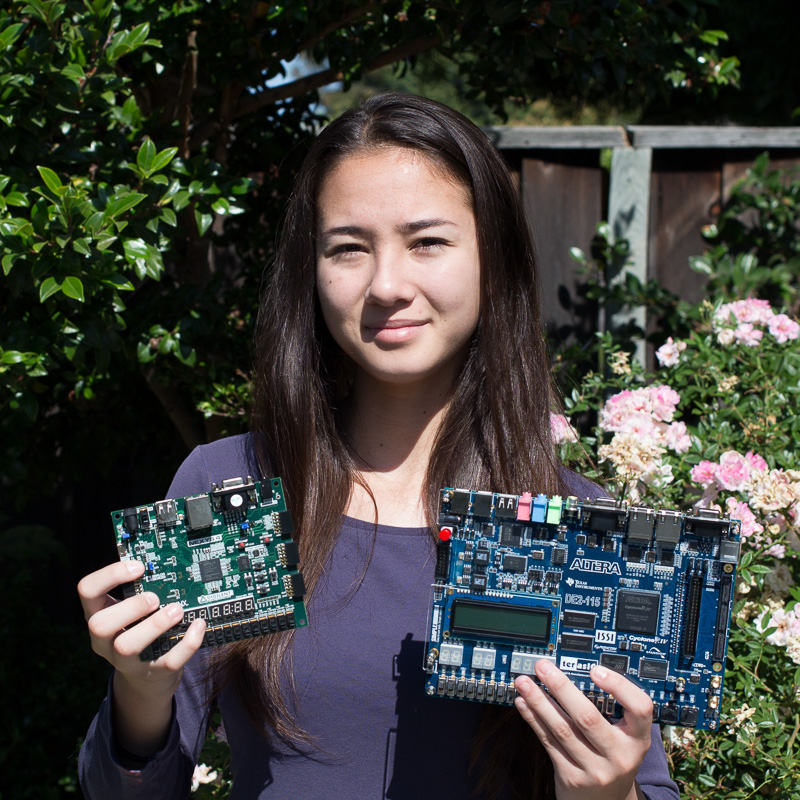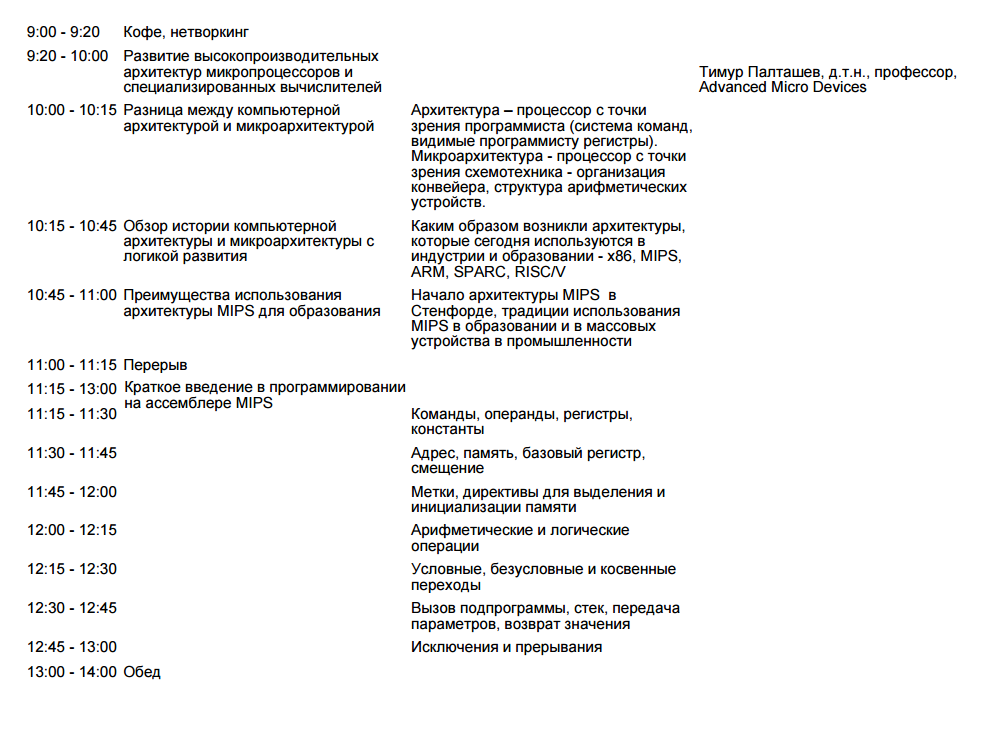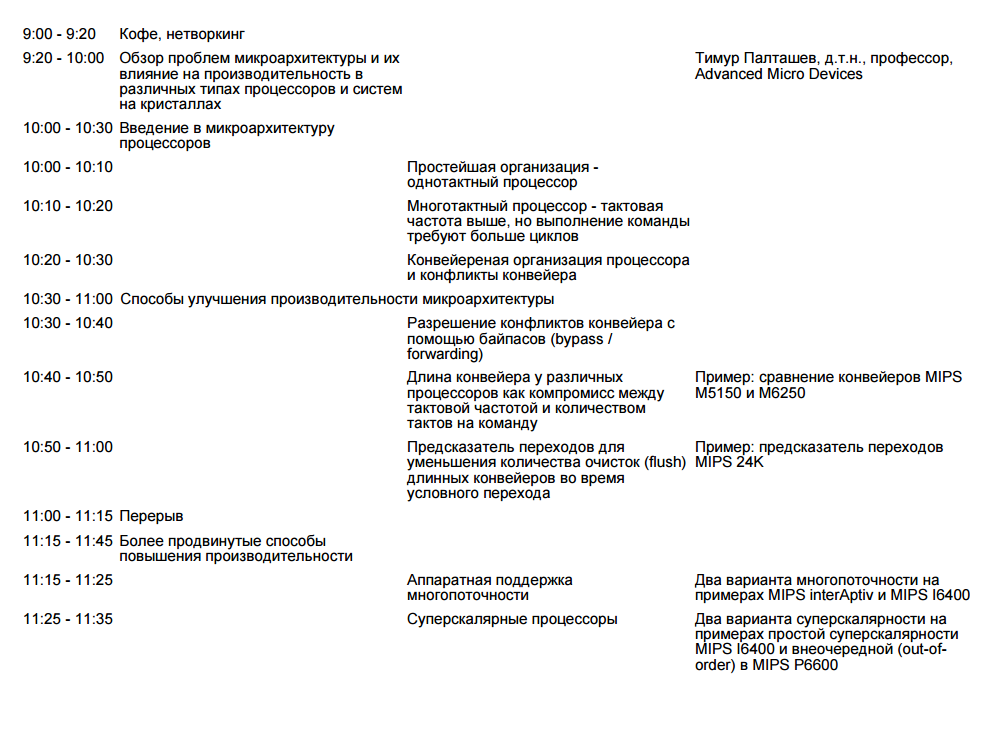Seminars on introducing everything: from verilog and digital logic to micro-architecture of embedded processors and RTOS
Lord We with Timur Paltashev from AMD in Sunnyvale, California, and also with several colleagues from Russia, Ukraine and Kazakhstan decided to plan several seminars of different formats that cover topics at the junction of hardware and software: digital logic, Verilog, RTL rules (Register Transfer Level) , an introduction to the microarchitecture (pipeline structure) of processors, low-level programming in assembler, the use of microcontrollers, features of chips for the Internet of things, an introduction to RTOSs, labs on FPGAs / FPGAs, and also (for a part of the audience that interests I have a factory producing chips) the physical aspects of the design and manufacture (for the latter, we have decided to bring materials from the instructor of the course at the University of California, Santa Cruz, an office in Silicon Valley).
The purpose of this post is to discuss who likes what on the basis of the detailed plan of the first of such seminars, which will be in Kazakhstan . The idea of this seminar is to invite some of the teachers of Kazakhstani universities and make a review for them to help them find out in which places they can improve the quality of their programs in embedded systems programming, electronics, and also affect related areas such as the Internet of things and robotics.

')
About most of the materials on which everything is built, I already wrote on Habré:
1. Russian translation of the textbook by David Harris and Sarah Harris “Digital circuit design and computer architecture”, the post about which received 140 thousand views on Habré and which is used by teachers in many universities, including the Moscow Institute of Physics and Technology.
2. A course on Microchip PIC32MZ microcontrollers , created by Professor Alexander Dean from the University of North Carolina, in collaboration with Imagination Technologies, Microchip Technology and Digilent (National Instruments department), which also worked on Russian universities, including MIET in Zelenograd and SSAU in Samara.
3. MIPSfpga is a package that contains the processor core in the source code on Verilog, which can be changed, add new instructions, build multiprocessor systems, simultaneously change software and hardware, etc. See also post How to parse text with bare hardware, without a processor and without software about one of the MIPSfpga blocks.
In addition, already after Kazakhstan, we plan to involve for the preparation of seminars in Russia and Ukraine a teacher from the UC Santa Cruz Extension in Silicon Valley named Charles Dankak who allowed me to make a short clipping from the slides of his course “Development of Nanometer- Specified ICs: From Specification to silicon " :

But now for your criticism schedule in Kazakhstan. I wonder who would put the accents like:











To substantiate the workshop in Kazakhstan to its organizers, I wrote the following text:
The seminar is aimed at the following groups of university lecturers:
1. Teachers of digital circuitry, interested in improving their existing courses. At the seminar, we will present the Russian translation of the popular textbook by David Harris and Sarah Harris “Digital Circuit Design and Computer Architecture”, which, in addition to introducing the basics of digital logic, introduces Verilog and VHDL hardware description languages, and also shows the student how to build his own conveyor microprocessor , which can be implemented on low-cost student boards with FPGA chips.
Students who have studied digital circuitry based on hardware description languages will be able to use FPGA chips for prototyping and developing electronic devices for network devices, sound processing, and other applications.
2. Teachers of programming in high-level languages who are interested in expanding their courses through the inclusion of low-level programming in MIPS assembler, one of the three main architectures (ARM, MIPS, x86), which are used in embedded systems.
Students who have studied this material will be able to specialize in programming microcontrollers (for example Microchip PIC32MZ) and embedded processors (for example MediaTek MT7688), with the widest range of applications - in transport, agro-industrial systems and the Internet of things. In addition, students will be able to specialize in areas that require knowledge of low-level programming — writing compilers, operating system kernels, and hypervisors for virtualization.
3. Microcontroller programming instructors who want to improve their courses using the Connected MCU course developed at the University of North Carolina, in collaboration with Imagination Technologies, Microchip Technology and Digilent (National Instruments Division).
In addition to discussing microcontroller interfaces with peripheral devices, this course contains elements of the micro-architecture of the microprocessor core and the operation of caches, which helps students analyze performance. In addition, the course consistently, step by step, teaches writing parallel programs, starting from explaining the mechanism of interrupts and the use of timers, and ending with laboratory work with the real-time operating system FreeRTOS.
4. Teachers of specialized disciplines, such as robotics. This discipline is used by embedded processors and requires an understanding of both the hardware and the software part of the system. The workshop materials contain an explanation of the difference between various classes of processors - from simple microcontrollers that are used to control mechanical manipulators to high-performance multi-core superscalar embedded computers that are used to process visual information sent to the cameras of the robot.
5. Teachers who want to introduce teaching systems design on a chip that is new to many universities (System on Chip - SoC). Now even small companies in the field of the Internet of things have begun to design their own specialized systems on a chip, connecting cost-effective processor cores with their own periphery, and then using contract manufacturing of such chips in China. The MIPSfpga package, which is contained in the seminar materials, allows you to prototype such systems using low-cost FPGA student cards.
In general, the seminar allows teachers of various specializations in electronics and programming to get a general idea of related fields, as well as what is happening in the industry, as well as select areas of specialization and student projects for their universities.
The purpose of this post is to discuss who likes what on the basis of the detailed plan of the first of such seminars, which will be in Kazakhstan . The idea of this seminar is to invite some of the teachers of Kazakhstani universities and make a review for them to help them find out in which places they can improve the quality of their programs in embedded systems programming, electronics, and also affect related areas such as the Internet of things and robotics.

')
About most of the materials on which everything is built, I already wrote on Habré:
1. Russian translation of the textbook by David Harris and Sarah Harris “Digital circuit design and computer architecture”, the post about which received 140 thousand views on Habré and which is used by teachers in many universities, including the Moscow Institute of Physics and Technology.
2. A course on Microchip PIC32MZ microcontrollers , created by Professor Alexander Dean from the University of North Carolina, in collaboration with Imagination Technologies, Microchip Technology and Digilent (National Instruments department), which also worked on Russian universities, including MIET in Zelenograd and SSAU in Samara.
3. MIPSfpga is a package that contains the processor core in the source code on Verilog, which can be changed, add new instructions, build multiprocessor systems, simultaneously change software and hardware, etc. See also post How to parse text with bare hardware, without a processor and without software about one of the MIPSfpga blocks.
In addition, already after Kazakhstan, we plan to involve for the preparation of seminars in Russia and Ukraine a teacher from the UC Santa Cruz Extension in Silicon Valley named Charles Dankak who allowed me to make a short clipping from the slides of his course “Development of Nanometer- Specified ICs: From Specification to silicon " :

But now for your criticism schedule in Kazakhstan. I wonder who would put the accents like:











To substantiate the workshop in Kazakhstan to its organizers, I wrote the following text:
The seminar is aimed at the following groups of university lecturers:
1. Teachers of digital circuitry, interested in improving their existing courses. At the seminar, we will present the Russian translation of the popular textbook by David Harris and Sarah Harris “Digital Circuit Design and Computer Architecture”, which, in addition to introducing the basics of digital logic, introduces Verilog and VHDL hardware description languages, and also shows the student how to build his own conveyor microprocessor , which can be implemented on low-cost student boards with FPGA chips.
Students who have studied digital circuitry based on hardware description languages will be able to use FPGA chips for prototyping and developing electronic devices for network devices, sound processing, and other applications.
2. Teachers of programming in high-level languages who are interested in expanding their courses through the inclusion of low-level programming in MIPS assembler, one of the three main architectures (ARM, MIPS, x86), which are used in embedded systems.
Students who have studied this material will be able to specialize in programming microcontrollers (for example Microchip PIC32MZ) and embedded processors (for example MediaTek MT7688), with the widest range of applications - in transport, agro-industrial systems and the Internet of things. In addition, students will be able to specialize in areas that require knowledge of low-level programming — writing compilers, operating system kernels, and hypervisors for virtualization.
3. Microcontroller programming instructors who want to improve their courses using the Connected MCU course developed at the University of North Carolina, in collaboration with Imagination Technologies, Microchip Technology and Digilent (National Instruments Division).
In addition to discussing microcontroller interfaces with peripheral devices, this course contains elements of the micro-architecture of the microprocessor core and the operation of caches, which helps students analyze performance. In addition, the course consistently, step by step, teaches writing parallel programs, starting from explaining the mechanism of interrupts and the use of timers, and ending with laboratory work with the real-time operating system FreeRTOS.
4. Teachers of specialized disciplines, such as robotics. This discipline is used by embedded processors and requires an understanding of both the hardware and the software part of the system. The workshop materials contain an explanation of the difference between various classes of processors - from simple microcontrollers that are used to control mechanical manipulators to high-performance multi-core superscalar embedded computers that are used to process visual information sent to the cameras of the robot.
5. Teachers who want to introduce teaching systems design on a chip that is new to many universities (System on Chip - SoC). Now even small companies in the field of the Internet of things have begun to design their own specialized systems on a chip, connecting cost-effective processor cores with their own periphery, and then using contract manufacturing of such chips in China. The MIPSfpga package, which is contained in the seminar materials, allows you to prototype such systems using low-cost FPGA student cards.
In general, the seminar allows teachers of various specializations in electronics and programming to get a general idea of related fields, as well as what is happening in the industry, as well as select areas of specialization and student projects for their universities.
Source: https://habr.com/ru/post/304612/
All Articles